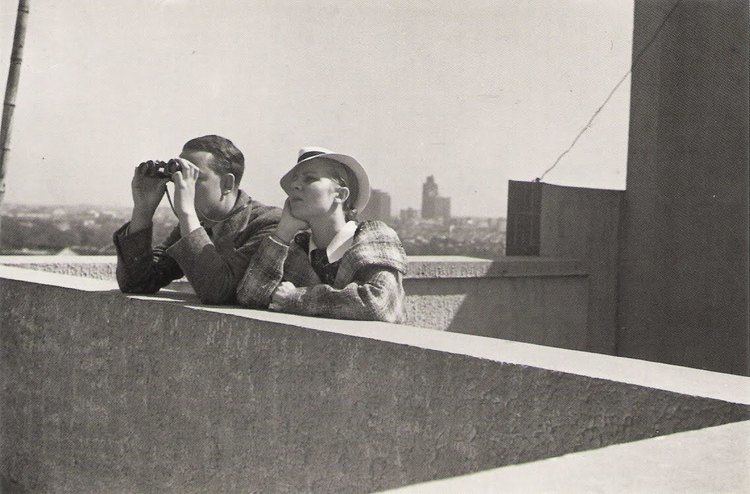Name Sam Tata | ||
 | ||
Awards Lifetime Achievement Award, Canadian Association of Professional Image Creators (CAPIC), 1990 Books A certain identity: 50 portraits, Tata: A Life in Photographs, India: Land of My Fathers | ||
Sam Tata (September 30, 1911 – July 3, 2005) was a noted photographer and photojournalist.
Contents

Early life
Sam Bejan Tata was born in Shanghai, China, on September 30, 1911, to a wealthy, mercantile Parsi family. He graduated from Shanghai Public School, and then studied business for two years at the University of Hong Kong. He took up photography at the age of twenty-four, and was one of the founding members of the Shanghai Camera Club. A friend at the club, Alex Buchman, who was working as a photojournalist for the China Press, inspired Tata to buy his first Leica and roam the streets for meaningful images. In 1939, he learned academic studio portraiture with Oscar Seepol, and he later studied with the photographers Chin San Long and Liu Shu Chong. In his early photographs, he became adept in the use of lighting and in the additive techniques favoured by the pictorialists. His focus on portraiture in these years was partly dictated by the Japanese occupation of Shanghai in 1937, and Tata was not able to take up photography full-time until 1946. In 1956 Sam Tata immigrated to Canada and established himself in Montreal.
Bombay and Henri Cartier-Bresson
In 1947, through the efforts of the Indian pictorialist Jehanghir Unwalla, Tata's work was shown in Bombay. Several months later, at a show sponsored by the Bombay Art Society, he met French photographer Henri Cartier-Bresson, and through his influence and mentorship, was galvanized to take up photojournalism with renewed vigour. He began to contribute to Bombay periodicals such as Trend and Flashlight. With Cartier-Bresson, Tata documented the Indian Independence movement from 1946–1948, including the assassination of Mahatma Gandhi. In 1949, Tata returned to Shanghai, where he recorded the fall of the Kuomintang and the takeover of the city by Communist troops; for a period he was accompanied by Cartier-Bresson who stayed with Tata and his family. Tata remained in the city until 1952, when he moved to Hong Kong. He made a trip to Kashmir and India in 1955, and his photo-essay, "Himalyan Pilgrimage", was published by National Geographic in October 1956.
Montreal and later years
Tata immigrated to Canada in 1956 and settled in Montreal. He quickly found work doing stills for documentary films made at the National Film Board, and he became a photo editor for The Montrealer magazine. His work appeared in publications and magazines such as Macleans, Perspectives, Chatelaine, and Time. Sometimes on assignment, but increasingly on his own initiative, he began to amass a portfolio of Canadian literary and artistic figures, including Michel Tremblay, Leonard Cohen, Michael Laucke, Irving Layton, George Bowering, Donald Sutherland, Alice Munro, and Gilles Vigneault. Tata preferred to take pictures with a 35mm camera and use the available light in the homes of his subjects, where they would feel more at ease and their personalities be more fully evoked by posing amidst their personal possessions. In 1988, a major retrospective of his life and work, The Tata Era / L’Epoque Tata was mounted by the Canadian Museum of Contemporary Photography and toured the country. He was made a member of the Royal Canadian Academy of Arts, and was awarded the lifetime achievement award in 1990 from the Canadian Association of Professional Image Creators (CAPIC). In 1991, forty of his photographs appeared in the National Library of Canada exhibition, Canadian Writers at the National Library of Canada. Books devoted to his photography include Montreal (with Frank Lowe, 1963), Expo 67: Sculpture (1967), A Certain Identity: 50 Portraits (1983), Shanghai 1949: The End of an Era (1989), Portraits of Canadian Writers (1991), and India: Land of My Fathers (2005). Sam Tata died July 3, 2005 at the age of 93 in Sooke, British Columbia, Canada.
On April 8, 2015, Canada Post issued a permanent domestic stamp with a photograph entitled Angels, Saint-Jean-Baptiste Day, taken in Montreal by Sam Tata in 1962.
